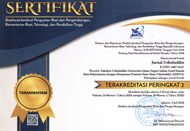Examining Semitic Rhetoric: A Qur’anic Sciences Perspective
Abstract
Keywords
Full Text:
PDFReferences
‘Abbas, Fad}l H{asan. I‘ja>z al-Qur’a>n al-Kari>m. Amman: Da>r al-Nafa>is, 2015>.
“Michel Cuypers, P.F.J.” https://www.ideo-cairo.org/en/michel-cuypers-p-f-j-2/. Internet. Accessed on 24 February 2020.
Asnawi, Aqdi Rofiq. “Penerapan Semitic Rhetoric Analysis (SRA) pada Surah al-Qiya>mah,” Mutawatir: Jurnal Keilmuan Tafsir Hadith 8, No. 1 (2018), 143-169.
Attallah, Halla. “Michel Cuypers, The Composition of the Qur’an: Rhetorical Analysis, translated by Jerry Ryan. London / New York: Bloomsbury Academic, 2015.” Der Islam 95, No. 1 (2018): 211-217.
Bell, Richard. The Qur’a>n: Translated, with a critical re-arrangement of the Surahs. Edinburgh: T. & T. Clark, 1939.
Biqa>‘i>, Ibra>him bin ‘Umar. Naz}mu al-Durar fi> Tana>subi al-A>ya>t wa al-Suwar. Kairo: Da>r al-Kutub al-Isla>mi>, n. d.
Boisliveau, Anne-Sylvie. “Reviewed Work: Le Festin: Une lecture de la sourate al-Mâ'ida by Michel Cuypers”. Journal of Qur’anic Studies 9, No. 1 (2007): 119-23.
Cuypers, Michel. “Semitic Rhetoric as a Key to the Question of the Naz}m of the Qur’anic Text”. Journal of Qur’anic Studies 13, No. 1 (2011): 1-24.
_______. Fi> Naz}mi al-Qur’a>n. Transleted from English, The Composition of the Qur’an: Rhetorical Analysis, by ‘Adna>n al-Muqra>ni> dan T{a>riq Manzu>. Beirut: Da>r al-Masyriq, 2018.
_______. Fi> Naz}mi Su>rati al-Ma>’idah: Naz}mu An fi> D{aw’i Manhaji al-Tah}li>l al-Bala>ghi>. . Transleted from English, The Banquet: A reading of the fifth Sura of the Qur’an, by ‘Amr Abd al-‘A S{a>lih}. Beirut: Da>r al-Masyriq, 2016.
Douglas, Mary. Thinking in Circles: An Essay on Ring Composition. New Haven and London: Yale University Press, 2007.
Farrin, Raymond. Structure and Qur’anic Interpretation: A Study of Symmetry and Coherence in Islam’s Holy Text. Ashland, Oregon: White Cloud Press, 2014.
H{awwa>, Sa‘i>d. Al-Asa>s fi> al-Tafsi>r. Kairo: Da>r al-Sala>m, 1424.
H{usayn, Muh}ammad. al-Mustasyriqu>n wa al-Dira>sa>t al-Qur’a>niyyah. Beirut: Da>r al-Muarrikh al-‘Arabiy, 1999.
Ibn ‘A>syu>r. Al-Tah}ri>r wa al-Tanwi>r. Tunis: al-Da>r al-Tu>nisiyyah li al-Nasyr, 1984.
Idri. Hadis dan Orientalis. Depok: Kencana, 2017.
Izutsu, Toshihiko. God and Man in the Qur’an: Semantics of the Qur’anic Weltanschauung. Petaling Jaya: Islamic Book Trust, 2008.
al-Khat}t}a>bi>. Baya>n I‘ja>z al-Qur’a>n. Kairo: Da>r al-Ma‘a>rif, 1976.
Meynet, Roland. Rhetorical Analysis: An Introduction to Biblical Rhetoric (Sheffield: Sheffield Academic Press, 1998.
_______. Treatise on Biblical Rhetoric. Transl. Leo Arnold. Leiden and Boston: Brill, 2012.
Mir, Mustansir. Coherence in the Qur’a>n. A Study of Isla>hi>’s Concept of Naz}m in Taddabur-i Qur’a>n. Indianapolis: American Trust Publications, 1986.
Mokrani, Adnane. “Semitic Rhetoric and the Qur’ān: The Scholarship of Michel Cuypers.” In New Trends in Qur’ anic Studies: Text, Context, and Interpretation. Ed. Mun’im Sirry. Atlanta, Georgia: Lockwood Press, 2019.
al-Mujawwad, Muhammad Yaslam. "Manhaj al-Bala>ghah al-Sa>miyah fi Dira>sah Bunyat al-Qur’a>n al-Kari>m," https://tafsir.net/research/41/mnhj-al-blaght-as-samy-yt-fy-drast-bnyt-al-qr-aan-al-krym-drast-wsfyt-nqdyh. Internet. Accessed on 24 February 2020.
Nasir, M. Ridlwan. Perspektif Baru Metode Tafsir Muqarin dalam Memahami al-Qur’an. Surabaya: Imtiyaz, 2011.
Netton, Ian Richard. “Towards a Modern Tafsir of Surah al-Kahf: Structure and Semiotics.” Journal of Qur’anic Studies 2, No. 1 (2000): 67-87.
al-Qat}t}a>n, Manna>’. Maba>h}ithun fi> ‘Ulu>m al-Qur’a>n. Kairo: Maktabatu Wahbah, n. d..
al-Ra>zi>, Fakhr al-Di>n. Mafa>ti>h al-Ghayb. Beirut: Da>r Ih}ya>’ al-Tura>th al-‘Arabi>, 1420.
Reynolds, Gabriel Said. “Buchbesprechungen.” Der Islam 88, No. 2 (2012): 427–434.
Robinson, Neal. Discovering the Qur’an: A Contemporary Approach to a Veiled Text. London: SCM Press, 1996.
Rodwell, J. M.. The Koran. New York: Dover Publication, 2005.
Saleh, Walid. “The Etymological Fallacy and Qur’anic Studies: Muhammad, Paradise, and Late Antiquity.” In The Qur’an in Context. Ed. Angelika Neuwirth, Nicolai Sinai, Michael Marx. Leiden: Brill, 2010.
Shihab, M.Quraish. Kaidah Tafsir. Tangerang: Lentera Hati, 2015.
Sinai, Nicolai. “Review Essay: ‘Going Round in Circles’: Michel Cuypers, The Composition of the Qur’an: Rhetorical Analysis, and Raymond Farrin, Structure and Qur’anic Interpretation: A Study of Symmetry and Coherence in Islam’s Holy Text”. Journal of Qur’anic Studies19, No. 2 (1 Juni 2017): 106-122.
al-Suyu>t}i>, ‘Abd al-Rah}ma>n. Al-Itqa>n Fi> ‘Ulu>m al-Qur’a>n. Mesir: al-Hay’ah al-al-Mishriyyah ‘Ammah Li al-Kita>b, 1974.
Tilawati, Anis. “Struktur Cincin Dalam al-Qur’an (Perspektif Orientalis-Nicolai Sinai)”. Nun: Jurnal Studi al-Qur’an dan Tafsir di Nusantara 4, No. 2 (2018): 51-77.
Wolfensohn, Israel. Ta>rikh al-Lugha>t al-Sa>miyyah. Beirut: Da>r al-Qalam, 2016.
Zahniser, Matthias. “Major Transitions and Thematic Borders in Two Long Sūras: Al-Baqara and al-Nisa’.” In Literary Structures of Religious Meaning.Ed. Issa Boullata. Richmond: Curzon Press, 2000.
al-Zarkasyi>, Badr al-Di>n. Al-Burha>n fi> ‘Ulu>m al-Qur’a>n. Beirut: Da>r al-Ma‘rifah, 1957.
al-Zurqa>ni>, Muh}ammad. Mana>hil al-‘Irfa>n Fi> ‘Ulu>m al-Qur’a>n. Aleppo: Mat}ba‘ah ‘I al-Ba>bi, n.d.
DOI: http://dx.doi.org/10.24014/jush.v28i2.9898
Refbacks
- There are currently no refbacks.
 Jurnal Ushuluddin Indexed By:
Jurnal Ushuluddin Indexed By:
Alamat Redaksi:
 Fakultas Ushuluddin UIN SUSKA Riau Jl. H.R. Soebrantas KM. 15,5 Panam – Pekanbaru
Fakultas Ushuluddin UIN SUSKA Riau Jl. H.R. Soebrantas KM. 15,5 Panam – Pekanbaru
 E-mail: jurnal.ushuluddin@uin-suska.ac.id
E-mail: jurnal.ushuluddin@uin-suska.ac.id
ejournal: http://ejournal.uin-suska.ac.id/index.php/ushuludin

Jurnal Ushuluddin is licensed under a Lisensi Creative Commons Atribusi 4.0 Internasional.


















